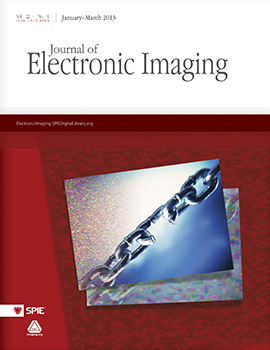Yan Shen, Hak Chul Shin, Won Jun Sung, Sarang Khim, Honglak Kim, Phill Kyu Rhee
Journal of Electronic Imaging, Vol. 22, Issue 01, 013031, (March 2013) https://doi.org/10.1117/1.JEI.22.1.013031

TOPICS: Eye, Detection and tracking algorithms, Video, Human-computer interaction, Iris recognition, Genetics, Image quality, Evolutionary algorithms, Feature extraction, Hough transforms
We present an evolutionary adaptive eye-tracking framework aiming for low-cost human computer interaction. The main focus is to guarantee eye-tracking performance without using high-cost devices and strongly controlled situations. The performance optimization of eye tracking is formulated into the dynamic control problem of deciding on an eye tracking algorithm structure and associated thresholds/parameters, where the dynamic control space is denoted by genotype and phenotype spaces. The evolutionary algorithm is responsible for exploring the genotype control space, and the reinforcement learning algorithm organizes the evolved genotype into a reactive phenotype. The evolutionary algorithm encodes an eye-tracking scheme as a genetic code based on image variation analysis. Then, the reinforcement learning algorithm defines internal states in a phenotype control space limited by the perceived genetic code and carries out interactive adaptations. The proposed method can achieve optimal performance by compromising the difficulty in the real-time performance of the evolutionary algorithm and the drawback of the huge search space of the reinforcement learning algorithm. Extensive experiments were carried out using webcam image sequences and yielded very encouraging results. The framework can be readily applied to other low-cost vision-based human computer interactions in solving their intrinsic brittleness in unstable operational environments.



 Receive Email Alerts
Receive Email Alerts